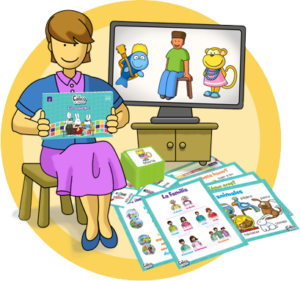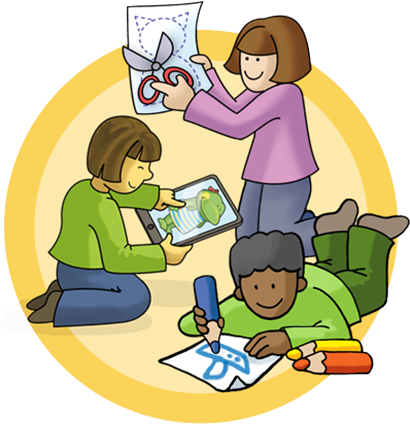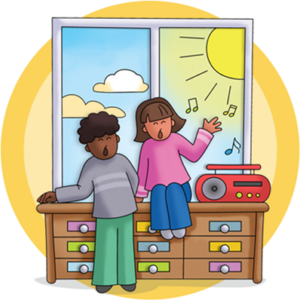Philosophy

Curriculum Design
Calico Spanish is an effective, all-encompassing curriculum designed to engage language learners in a fun, learner-centered immersion environment. Rather than overwhelming learners with long vocabulary lists and complex grammatical explanations, Calico Spanish integrates key elements of language in achievable chunks. New vocabulary and concepts are presented in contextualized, bite-sized portions and reinforced through games, songs, and engaging activities. Calico Spanish’s research-based approach leads learners to gain foundational Spanish skills, practice existing language skills, and explore new skills that build gradually in complexity and application. The curriculum's vibrant graphics set a cheerful tone, attracting eager learners, and custom visuals allow teachers to communicate new concepts with ease.

For Teachers
Calico Spanish provides an incredible foundation for teaching language to young learners. As such, teachers can easily foster a Spanish immersion environment in ways that meet the diverse needs of their students. The Calico Spanish curriculum expertly weaves research-based instructional strategies into over 300 hours of ready-to-teach lesson plans, engaging learners and ensuring an enjoyable Spanish learning experience. From the initial presentation to the final assessment, the curriculum’s interactive lessons and customizable conversation activities empower learners to express unique ideas and identities in Spanish, fostering a love for the language and culture.

For Students
Calico Spanish caters to various learning styles, creating a student-centered instructional environment. Through vibrant visual aids, catchy music, and Total Physical Response (TPR) activities, learners discover language for themselves, making the learning process purposeful and personal. By actively engaging with the curriculum, students better retain the language and seek opportunities to use their communicative skills in real life scenarios. Calico Spanish's inquiry-based culture capsules guide learners in exploring the diverse cultures of Spanish-speaking peoples, further enriching learners’ experiences. In addition, the curriculum's interactive lessons and fun activities provide abundant opportunities for learners to interact with others in Spanish, strengthening a sense of community in the classroom environment.

Outcomes
Observing the outcomes of the Calico Spanish curriculum is a testament to its effectiveness. By the end of the curriculum, young learners gain communicative competence in Spanish, responding to questions with full sentences and expressing independent ideas. The curriculum's structured progression allows learners to articulate complex ideas, ask and answer intricate questions, and accomplish tasks independently. Calico Spanish not only helps learners on their way to multilingualism and literacy but also instills confidence in learners to use their developing language skills. Through engaging activities and interactive lessons, learners are empowered to use Spanish comfortably, fostering a sense of achievement and community in the classroom.
References
Bailey, F., & Fahad, A. K. (2021). Krashen Revisited: Case Study of the Role of Input, Motivation and Identity in Second Language Learning. Arab World English Journal, 12(2), 540–550.
Chen, C. (2020). A study on positive transfer of native language and second language teaching methods. Theory and Practice in Language Studies, 10(3), 306-312. https://doi.org/10.17507/tpls.1003.06
Gass, S. M., MacKey, A., & Pica, T. (1998). The Role of Input and Interaction in Second Language Acquisition: Introduction to the Special Issue. The Modern Language Journal, 82(3), 299–307. http://www.jstor.org/stable/329956
Horverak, M. O., Langeland, G. M., Løvik, A., Askland, S., Scheffler, P., & Wach, A. (2022). Systematic Work with Speaking Skills and Motivation in Second Language Classes. IAFOR Journal of Education, 10(1), 33–52. https://doi.org/10.22492/ije.10.1.02
Marinova-Todd, S. H., Marshall, D. B., & Snow, C. E. (2000). Three Misconceptions about Age and L2 Learning. TESOL Quarterly, 34(1), 9–34. https://doi.org/10.2307/3588095
Ozfidan, B., & Burlbaw, L. M. (2019). A Literature-Based Approach on Age Factors in Second Language Acquisition: Children, Adolescents, and Adults. International Education Studies, 12(10), 27–36.
Zhang, S. (2009). The Role of Input, Interaction and Output in the Development of Oral Fluency. English Language Teaching, 2(4), 91-100.
